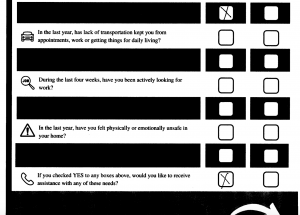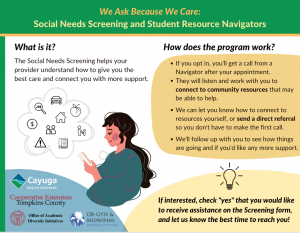A New Week, A New Pivot
Feeling a bit optimistic this week, as things are starting to move forward in a new direction. The program pivot to support no-shows was approved by the OBGYN office, and I worked on developing materials this week to implement this shift.
Many of the current stalls we have been facing are due to capacity reasons–the OB-GYN office has been chronically understaffed, and especially so in recent years. Although we have the drive to bring in programming that will be helpful in the future, the actual capacity of administration to add additional changes has made this difficult. As such, I am thankful that we are able to help address one part of the workload, which is accounting for no-show patients and their needs. Laura let us know that there are around 10-20/week, with referrals coming in immediately, which meant that we had to quickly adjust our scripts and workflows to account for the influx.
Essentially, the basic processes are the same: the contact information of no-show patients (those who do not make it to their appointment) will be sent to us–the student navigators–through the PtRefs system. While the call structure will differ slightly, the resources and support that we were planning to offer will be the same.
We have also discussed bringing this program to Day Reporting Probation Program in Tompkins County, of which Jen at CCE helps run programming for. This is very exciting to me as a potential prospect, especially since I’ve learned about the program and what it does through my CCE course last semester. If this shift were to take place, the social needs screening form would be readily applicable, although some resources may be less relevant, such as the doula services.
Documentation: Edits and Finalization
The longer I work on various projects, the more I realize just how detailed every piece of the project is. I find this to be especially true for pilot programs, since we’re constantly creating and troubleshooting as we go. One example of this is considering the pros and cons of various web storage platforms, as well as the ways in which we can store our information in conjunction with what local health partners already use. We have been considering a few different platforms to store medical information–Sharepoint, a Microsoft folder, etc.–and have finally decided on Box, which is also getting implemented this week.
To account for this web platform shift, some materials I’ve been working on this past week include new documentation forms we will store in Box. I’ve been finalizing a large excel sheet, including working through the deceivingly simple task of creating a multi-check dropdown list. For example, I had to include code into the excel sheet to make this work, meaning that I had to turn the file into a macro: a file that has its own unique embedded programming. I actually found this to be very fun, and it reminded me of working through coding errors through Stata: something about troubleshooting, and finally resolving the issue, is so satisfying. Plus, it’s always interesting to see how many different things you can make using only Excel.

Research Interests and Visualization
After some more research on my end, I’ve decided that I want to focus in on the Health Policy and Public Health Communication aspects of this work. I have been reading about articles discussing the delayed returns associated with public health, in the sense that they are not always immediate. As such, ways to convincingly communicate the necessity of a program to stakeholders is key to long-term program implementation.
After discussing these ideas with my team, I’m planning to look more into Expectations Management and Logic Models. Additionally, I discussed with Grace and Jen the variations in impacts and outcomes: short-term, mid-term, and long-term, and the effectiveness of communicating real-wins in the short-term to promote continued investment in programs.
We also discussed how even the groundwork of developing partnerships with organizations is foundational, and I want to highlight this aspect of collaborating with local health organizations as part of that “leading time” as still being critically valuable. This discussion made me think about ways to connect these ideas visually, and I will be developing and refining graphic drafts in the next week or so.
Student Interviews
On the promotional side of things, I have been developing some social media materials. These may not be immediately used since we are currently pausing recruitment for the fall semester, but will be helpful for future marketing purposes and/or Cornell’s OADI and Health Advising offices.
I am also planning to interview all student navigators working on this program on their experience this summer during August on their experience, so I will be creating a questionnaire and scheduling meetings during the next week or so.
We are also looking into creating Federal Work-Study positions for students interested in the program, of which these materials can be used for reference.

While this pilot has not been as streamline as I had anticipated, I’ve also been learning that this type of troubleshooting is all part of the process of implementing new programming, especially when working with health organizations that already have their own administrative structures in place. I’m looking forward to seeing how this new direction of the pilot takes us and learning/analyzing more about patient needs in Tompkins County in the next few weeks!














